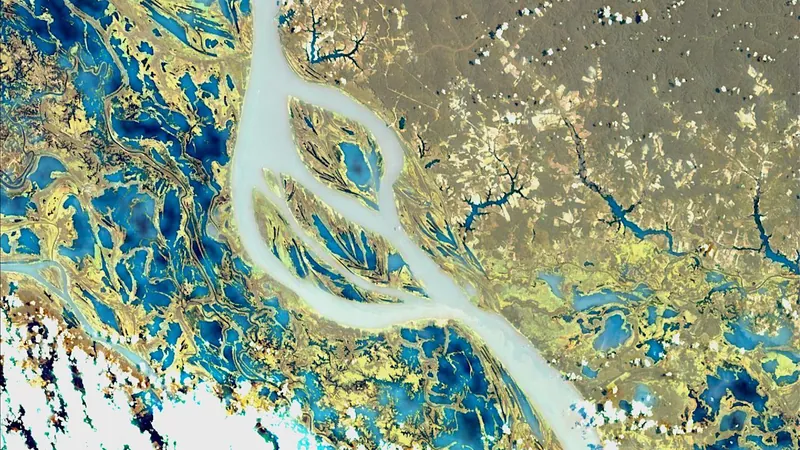
NASA's EMIT Captures Stunning Hyperspectral Image of the Amazon River: What This Means for Our Planet and Beyond!
2024-12-02
Author: Jacob
NASA is revolutionizing our understanding of Earth's ecosystems with cutting-edge technology, and the latest revelation comes from its Earth Surface Mineral Dust Source Investigation (EMIT) instrument. This remarkable sensor, mounted on the International Space Station (ISS), has successfully captured a breathtaking hyperspectral image of the Amazon River in the northern Brazilian state of Pará on June 30, 2024.
This stunning image not only showcases the beauty of our planet but also serves a critical scientific purpose. The vibrant tan and yellow shades represent lush vegetated land, while the vivid blue and turquoise tones highlight the flowing waters of the Amazon. Fluffy white clouds create an enchanting contrast overhead. This imagery is part of a groundbreaking dataset that aims to enhance our knowledge of global ecosystem biodiversity—crucial information as climate change continues to threaten our natural habitats.
Originally deployed in 2022 to map mineral compositions across Earth's deserts, EMIT has expanded its mission scope. Since early 2024, it has been utilized for an array of studies—ranging from agricultural monitoring and snow hydrology to investigating wildflower blooming cycles and the dynamics of phytoplankton in freshwater systems. The data collected helps scientists delve deeper into ecosystem diversity and the functional traits of forests.
How does this incredible technology work? EMIT employs advanced imaging spectrometers that capture the light reflected from Earth's surface. By separating visible and infrared light into hundreds of wavelengths, scientists can analyze patterns of reflection and absorption to identify the chemical composition of various materials. This innovative technique is paving the way for more efficient exploration and understanding of not only our planet but also potentially habitable worlds beyond Earth.
EMIT is not just a standalone hero; it lays the foundation for NASA's upcoming Surface Biology and Geology-Visible Shortwave Infrared (SBG-VSWIR) satellite mission. Expected to launch in the near future, SBG-VSWIR will provide even more frequent and detailed observations of Earth's terrestrial and coastal regions, offering finer spatial resolution than EMIT.
The significance of this work extends beyond Earth's boundaries. As humankind sets its sights on extraterrestrial exploration, mastering the art of planetary observation here at home is essential. The insights gained from EMIT's data could inform future missions to other planets, arming scientists with the knowledge they need to identify and study environments that may harbor life.
Stay tuned as NASA continues to unravel the mysteries of our planet and prepares for exciting new ventures in astrobiology! Don't miss out on future discoveries that could change our understanding of Earth and the universe!









 Brasil (PT)
Brasil (PT)
 Canada (EN)
Canada (EN)
 Chile (ES)
Chile (ES)
 España (ES)
España (ES)
 France (FR)
France (FR)
 Hong Kong (EN)
Hong Kong (EN)
 Italia (IT)
Italia (IT)
 日本 (JA)
日本 (JA)
 Magyarország (HU)
Magyarország (HU)
 Norge (NO)
Norge (NO)
 Polska (PL)
Polska (PL)
 Schweiz (DE)
Schweiz (DE)
 Singapore (EN)
Singapore (EN)
 Sverige (SV)
Sverige (SV)
 Suomi (FI)
Suomi (FI)
 Türkiye (TR)
Türkiye (TR)